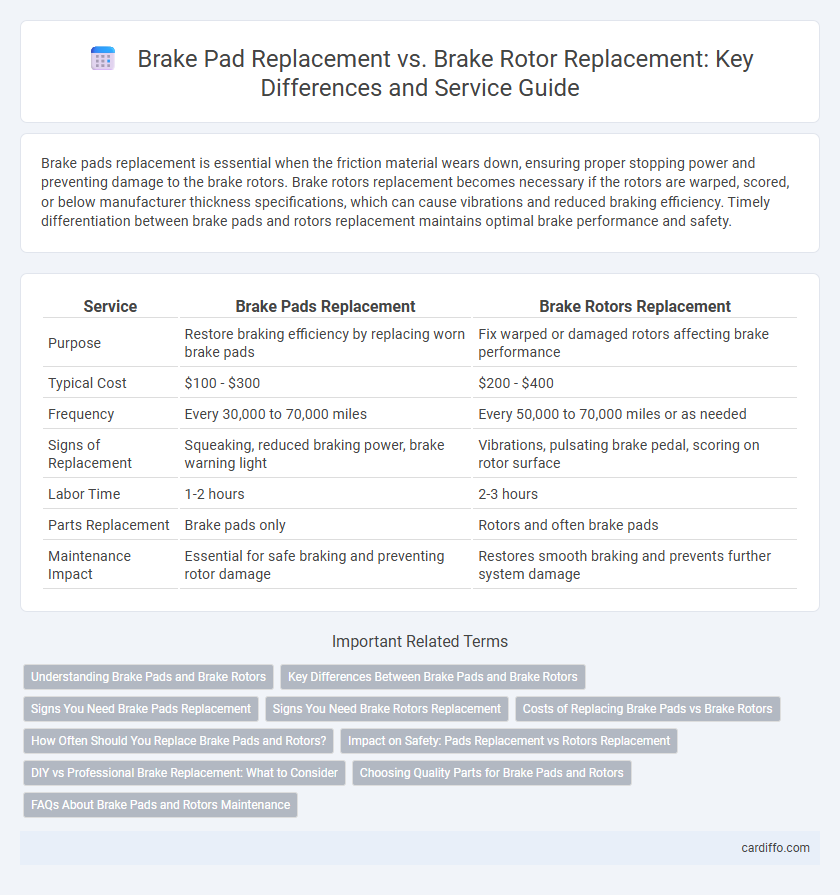Brake pads replacement is essential when the friction material wears down, ensuring proper stopping power and preventing damage to the brake rotors. Brake rotors replacement becomes necessary if the rotors are warped, scored, or below manufacturer thickness specifications, which can cause vibrations and reduced braking efficiency. Timely differentiation between brake pads and rotors replacement maintains optimal brake performance and safety.
Table of Comparison
| Service | Brake Pads Replacement | Brake Rotors Replacement |
|---|---|---|
| Purpose | Restore braking efficiency by replacing worn brake pads | Fix warped or damaged rotors affecting brake performance |
| Typical Cost | $100 - $300 | $200 - $400 |
| Frequency | Every 30,000 to 70,000 miles | Every 50,000 to 70,000 miles or as needed |
| Signs of Replacement | Squeaking, reduced braking power, brake warning light | Vibrations, pulsating brake pedal, scoring on rotor surface |
| Labor Time | 1-2 hours | 2-3 hours |
| Parts Replacement | Brake pads only | Rotors and often brake pads |
| Maintenance Impact | Essential for safe braking and preventing rotor damage | Restores smooth braking and prevents further system damage |
Understanding Brake Pads and Brake Rotors
Brake pads and brake rotors are critical components of a vehicle's braking system, each playing distinct roles in ensuring safe stopping power. Brake pads create friction against the rotors to slow down or stop the vehicle, while rotors provide a surface for this friction and dissipate heat generated during braking. Recognizing the difference between worn brake pads, which often cause squealing noises and reduced responsiveness, and damaged brake rotors, characterized by vibrations or grooves, is essential for timely and effective brake maintenance.
Key Differences Between Brake Pads and Brake Rotors
Brake pads and brake rotors serve distinct functions in a vehicle's braking system, with brake pads providing the friction needed to stop the wheels while brake rotors act as the surface that the pads clamp onto. Brake pads typically wear down faster and require more frequent replacement compared to brake rotors, which may only need replacement if they become warped or excessively worn. Understanding these key differences helps in diagnosing braking issues and determining whether a brake pads replacement or a brake rotors replacement is necessary for optimal vehicle safety.
Signs You Need Brake Pads Replacement
Worn brake pads often cause squealing or grinding noises during braking, signaling a need for immediate replacement to maintain safety. Reduced brake responsiveness or a longer stopping distance also indicate brake pads are thinning and require inspection. Visible grooves or a metal backing plate showing through the brake pads confirm urgent replacement before damaging the brake rotors.
Signs You Need Brake Rotors Replacement
Worn brake rotors often cause vibrations or pulsations when applying the brakes, signaling the need for rotor replacement. Visible scoring, grooves, or cracks on the rotor surface indicate severe wear that brake pads replacement alone cannot resolve. Reduced braking performance and increased stopping distances further confirm that new rotors are essential for vehicle safety.
Costs of Replacing Brake Pads vs Brake Rotors
Brake pads replacement typically costs between $150 and $300, while brake rotors replacement ranges from $300 to $700 due to the complexity and material costs involved. Brake rotors often require resurfacing or full replacement, which increases labor and parts expenses compared to the simpler brake pads change. Choosing to replace only brake pads minimizes immediate costs but may lead to higher expenses if worn rotors cause uneven brake wear.
How Often Should You Replace Brake Pads and Rotors?
Brake pads typically require replacement every 30,000 to 70,000 miles, depending on driving habits and vehicle type, while brake rotors generally last between 50,000 to 70,000 miles but may need earlier replacement if warped or deeply scored. Regular inspections during routine maintenance help assess pad thickness and rotor condition to prevent compromised braking performance. Ignoring wear signs can lead to costly repairs and reduced safety, making timely replacement critical for optimal brake system functionality.
Impact on Safety: Pads Replacement vs Rotors Replacement
Brake pads replacement directly affects braking performance by ensuring proper friction and stopping power, which is essential for preventing accidents. Brake rotors replacement is critical when warping or severe wear causes vibrations or reduced contact area, significantly impacting vehicle control during emergency stops. Neglecting either component compromises braking efficiency, increasing the risk of brake failure and endangering overall road safety.
DIY vs Professional Brake Replacement: What to Consider
Brake pads replacement typically requires less expertise and can often be handled by DIY enthusiasts using standard tools, whereas brake rotors replacement demands precise measurements and specialized equipment, making professional service advisable. Incorrect installation of brake rotors can lead to uneven wear, reduced braking efficiency, and safety hazards, highlighting the importance of professional assessment and replacement. Evaluating the condition of both brake pads and rotors ensures optimal braking performance and vehicle safety.
Choosing Quality Parts for Brake Pads and Rotors
Selecting high-quality brake pads and rotors is essential for maintaining optimal vehicle safety and performance. Premium brake pads offer superior friction materials that enhance stopping power and minimize wear, while durable rotors ensure even heat distribution and reduce the risk of warping. Investing in reputable brands with OEM specifications guarantees longevity and reliable braking under various driving conditions.
FAQs About Brake Pads and Rotors Maintenance
Brake pads typically require replacement every 30,000 to 70,000 miles depending on driving habits, while brake rotors last between 50,000 and 70,000 miles but may need resurfacing or replacing if warped or worn below minimum thickness. Common maintenance questions include how to detect brake pad wear signs like squealing or grinding noises and rotor issues such as vibration during braking. Regular inspections by certified mechanics help ensure optimal braking performance and safety by identifying worn pads or damaged rotors early.
Brake Pads Replacement vs Brake Rotors Replacement Infographic

 cardiffo.com
cardiffo.com